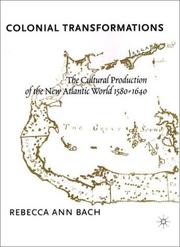| Listing 1 - 5 of 5 |
Sort by
|
Book
ISBN: 0823241181 1283297167 9786613297167 082323827X 0823232409 0823232387 Year: 2010 Publisher: New York : Fordham University Press,
Abstract | Keywords | Export | Availability | Bookmark
 Loading...
Loading...Choose an application
- Reference Manager
- EndNote
- RefWorks (Direct export to RefWorks)
This book intervenes in transatlantic and hemispheric studies by positing "America" as not a particular country or continent but a foundational narrative, in which conquerors arrive at a shore intent on overwriting local versions of humanity, culture, and landscape with inscriptions of their own design. This imposition of foreign textualities, however dominant, is never complete because the absences of the disappeared still linger manifestly, still are present. That apparent paradox results in a haunted America, whose conquest is always partial and whose conquered are always contestatory. Readers of scholarship by transatlanticists such as Paul Gilroy and hemispherists such as Diana Taylor will find new conceptualizations here of an America that knows no geographic boundaries, whose absences are collective but not necessarily interrelated by genealogy. The five principal texts at hand - Columbus's diary of his first voyage, the Popol Vuh of the Maya-K'iche', Defoe's Robinson Crusoe, Evita's Cuando los Combes luchaban (the first African novel in Spanish), and Pynchon's Mason & Dixon - are examined as foundational stories of America in their imaginings of its transatlantic commencement. Interspersed too are shorter studies of narratives by William Carlos Williams, Rigoberta Menchú, Álvar Núñez Cabeza de Vaca, José Martí, Mark Knopfler (former lead singer of Dire Straits) and Gabriel García Márquez. These texts are rarely if ever read together because of their discrete provenances in time and place, yet their juxtaposition reveals how the disjunctions and ruptures that took place on the eastern and western shores of the Atlantic upon the arrival of Europeans became insinuated as recurring and resistant absences in narratives ostensibly contextualized by the Conquest.The book concludes by proposing that Mary Shelley's Frankenstein is the great American novel.After Specters of Conquest: Indigenous Absence in Transatlantic Literatures, America will never seem the same.
Comparative literature --- Literature --- Literature, Comparative --- Philology --- Theory, etc. --- History and criticism --- America --- Western Hemisphere --- Hemisphere, Western --- New World --- Earth (Planet) --- Civilization --- In literature. --- Civilization. --- Literature History and criticism
Book
ISBN: 0814254950 0814276504 0814213782 Year: 2018 Publisher: Columbus, OH The Ohio State University Press
Abstract | Keywords | Export | Availability | Bookmark
 Loading...
Loading...Choose an application
- Reference Manager
- EndNote
- RefWorks (Direct export to RefWorks)
Most importantly, the book shows how literature constitutes an alternative public sphere for Black people. In a society largely controlled by white supremacist actors and institutions, Black authors have conjured fiction into a space where hard questions can be asked and answered and where the work of combatting collective, racist suppression can occur without replicating oppressive hierarchies. Intimate Antagonisms uncovers a key theme in Black fiction and argues that literature itself is a vital institutional site within Black life. Through the examination of intimate conflicts in a wide array of twentieth- and twenty-first-century novels, Blake demonstrates the centrality of intraracial relations to the complexity and vision of Black social movements and liberation struggles and the power and promise of Black narrative in reshaping struggle.
Social justice --- Equality --- Justice --- Western Hemisphere --- Hemisphere, Western --- New World --- Earth (Planet) --- Politics and government. --- Social conditions. --- History --- 20th century --- 21st century --- novels --- ethnic minorities --- black studies --- colonialism --- latin america --- USA --- literary studies

ISBN: 0312230990 9780312230999 Year: 2000 Publisher: New York Palgrave Macmillan
Abstract | Keywords | Export | Availability | Bookmark
 Loading...
Loading...Choose an application
- Reference Manager
- EndNote
- RefWorks (Direct export to RefWorks)
Colonies in literature. --- English literature --- Imperialism in literature. --- National characteristics, American, in literature. --- American influences. --- History and criticism --- Colonies in literature --- Imperialism in literature --- National characteristics, American, in literature --- American influences --- America --- Atlantic Ocean Region --- Western Hemisphere --- Hemisphere, Western --- New World --- Earth (Planet) --- Atlantic Area --- Atlantic Region --- In literature.
Book
ISBN: 9781108431828 9781107036673 1108431828 1107036674 1316547442 1316547116 1316547779 1316549429 1316548104 1139568124 131654513X 9781316548103 9781316549421 9781139568128 9781316549094 1316549097 Year: 2017 Publisher: Cambridge Cambridge University Press
Abstract | Keywords | Export | Availability | Bookmark
 Loading...
Loading...Choose an application
- Reference Manager
- EndNote
- RefWorks (Direct export to RefWorks)
Giants, cannibals and other monsters were a regular feature of Renaissance illustrated maps, inhabiting the Americas alongside other indigenous peoples. In a new approach to views of distant peoples, Surekha Davies analyzes this archive alongside prints, costume books and geographical writing. Using sources from Iberia, France, the German lands, the Low Countries, Italy and England, Davies argues that mapmakers and viewers saw these maps as careful syntheses that enabled viewers to compare different peoples. In an age when scholars, missionaries, native peoples and colonial officials debated whether New World inhabitants could - or should - be converted or enslaved, maps were uniquely suited for assessing the impact of environment on bodies and temperaments. Through innovative interdisciplinary methods connecting the European Renaissance to the Atlantic world, Davies uses new sources and questions to explore science as a visual pursuit, revealing how debates about the relationship between humans and monstrous peoples challenged colonial expansion.
Cartography --- Geography --- Monsters --- Symbolic aspects of monsters --- Symbolism --- Cosmography --- Earth sciences --- World history --- Cartography, Primitive --- Chartography --- Map-making --- Mapmaking --- Mapping (Cartography) --- Mathematical geography --- Surveying --- Map projection --- Maps --- History --- Sociological aspects --- Symbolic aspects --- 912:325 --- 912:930 --- 930.85 "15/17" --- 391/397 --- 391/397 Ethnografie --- Ethnografie --- Cartografie. Kaarten. Plattegronden. Atlassen-:-Landverhuizing. Kolonisatie. Immigratie. Emigratie --(politiek) --- Cartografie. Kaarten. Plattegronden. Atlassen-:-Geschiedwetenschap. Hulpwetenschappen der geschiedenis --- Cultuurgeschiedenis. Kultuurgeschiedenis--Moderne Tijd --- 930.85 "15/17" Cultuurgeschiedenis. Kultuurgeschiedenis--Moderne Tijd --- 912:930 Cartografie. Kaarten. Plattegronden. Atlassen-:-Geschiedwetenschap. Hulpwetenschappen der geschiedenis --- 912:930 Cartography. Maps. Atlasses-:-Geschiedwetenschap. Hulpwetenschappen der geschiedenis --- Cartography. Maps. Atlasses-:-Geschiedwetenschap. Hulpwetenschappen der geschiedenis --- 912:325 Cartografie. Kaarten. Plattegronden. Atlassen-:-Landverhuizing. Kolonisatie. Immigratie. Emigratie --(politiek) --- 912:325 Cartography. Maps. Atlasses-:-Landverhuizing. Kolonisatie. Immigratie. Emigratie --(politiek) --- Cartography. Maps. Atlasses-:-Landverhuizing. Kolonisatie. Immigratie. Emigratie --(politiek) --- Western Hemisphere --- Cartography - Europe - History - 16th century --- Cartography - Europe - History - 17th century --- Geography - Sociological aspects --- Monsters - Symbolic aspects --- Western Hemisphere - Maps --- Sociological aspects. --- Hemisphere, Western --- New World --- Earth (Planet)

ISBN: 9780813542225 0813542227 9780813542232 0813542235 0813543878 9780813543871 0813541972 0813541980 Year: 2008 Publisher: New Brunswick, N.J. Rutgers University Press
Abstract | Keywords | Export | Availability | Bookmark
 Loading...
Loading...Choose an application
- Reference Manager
- EndNote
- RefWorks (Direct export to RefWorks)
This landmark collection brings together a range of exciting new comparative work in the burgeoning field of hemispheric studies. Scholars working in the fields of Latin American studies, Asian American studies, American studies, American literature, African Diaspora studies, and comparative literature address the urgent question of how scholars might reframe disciplinary boundaries within the broad area of what is generally called American studies. The essays take as their starting points such questions as: What happens to American literary, political, historical, and cultural studies if we recognize the interdependency of nation-state developments throughout all the Americas? What happens if we recognize the nation as historically evolving and contingent rather than already formed? Finally, what happens if the "fixed" borders of a nation are recognized not only as historically produced political constructs but also as component parts of a deeper, more multilayered series of national and indigenous histories? With essays that examine stamps, cartoons, novels, film, art, music, travel documents, and governmental publications, Hemispheric American Studies seeks to excavate the complex cultural history of texts and discourses across the ever-changing and stratified geopolitical and cultural fields that collectively comprise the American hemisphere. This collection promises to chart new directions in American literary and cultural studies.
Sociology of culture --- America --- Hemisphere, Western --- Migrations of nations. --- Ethnic groups in literature. --- American literature --- Latin American literature --- Nations, Migrations of --- History and criticism. --- Western Hemisphere --- United States --- New World --- Americas --- U.S.A. --- Jungtinės Amerikos valstybės --- Soedinennye Shtaty Si︠e︡vernoĭ Ameriki --- Soedinennye Shtaty Severnoĭ Ameriki --- Si︠e︡vero-Amerikanskīe Soedinennye Shtaty --- Severo-Amerikanskie Soedinennye Shtaty --- Zlucheni Derz︠h︡avy --- USA --- US --- Arhab --- Ar. ha-B. --- Artsot ha-Berit --- ولايات المتحدة الامريكية --- Wilāyāt al-Muttaḥidah al-Amirīkīyah --- ABSh --- Amerika Birlăshmish Shtatlary --- ABŞ --- Amerika Birlăşmi Ştatları --- Forente stater --- Spojené staty americké --- Severo-Amerikanskie Shtaty --- Sjedinjene Američke Države --- Zʹi︠e︡dnani Derz︠h︡avy Ameryky --- Amerikai Egyesült Államok --- Yhdysvallat --- Verenigde Staten --- Egyesült Államok --- Hiwsisayin Amerikayi Miatsʻeal Tērutʻiwnkʻ --- Estados Unidos de América --- United States of America --- Fareyniḳṭe Shṭaṭn --- Artzois Ha'bris --- Estados Unidos da América do Norte --- SShA --- Soedinennye Shtaty Ameriki --- VSA --- États-Unis d'Amérique --- Vereinigte Staaten von Amerika --- Stati Uniti d'America --- Estados Unidos --- EE.UU. --- Stany Zjednoczone --- ĒPA --- Amerika Qūrama Shtattary --- Amerika Qŭshma Shtatlari --- SAD --- Saharat ʻAmērikā --- Hēnomenai Politeiai Amerikēs --- ZSA --- Mei-kuo --- Meiguo --- Mei guo --- ZDA --- Združene države Amerike --- U.S. --- America (Republic) --- Amirika Carékat --- Verenigde State van Amerika --- VS --- ولايات المتحدة --- Wilāyāt al-Muttaḥidah --- ولايات المتّحدة الأمريكيّة --- Wilāyāt al-Muttaḥidah al-Amrīkīyah --- Estatos Unitos --- Estatos Unitos d'America --- Ètats-Unis d'Amèrica --- Estaos Xuníos d'América --- Estaos Xuníos --- Tetã peteĩ reko Amérikagua --- Istadus Unidus --- Amerika Birlăşmiş Ştatları --- Amerika ka Kelenyalen Jamanaw --- Bí-kok --- Amerika Qushma Shtattary --- AQSh --- Злучаныя Штаты Амерыкі --- Zluchanyi︠a︡ Shtaty Ameryki --- Yunaeted Stet blong Amerika --- Yunaeted Stet --- Vaeinigte Staatn --- Vaeinigte Staatn vo Amerika --- Stadoù-Unanet Amerika --- Sŭedineni amerikanski shtati --- САЩ --- SASht --- Съединените щати --- Sŭedinenite shtati --- Америка (Republic) --- Amerika (Republic) --- Estats Units d'Amèrica --- Америкӑри Пӗрлешӳллӗ Штатсем --- Amerikări Pĕrleshu̇llĕ Shtatsem --- Stati Uniti --- SUA (Stati Uniti d'America) --- Unol Daleithiau America --- Unol Daleithiau --- Amerikas Forenede Stater --- Vereinigte Staaten --- Wááshindoon Bikéyah Ałhidadiidzooígíí --- Zjadnośone staty Ameriki --- Ameerika Ühendriigid --- Ηνωμένες Πολιτείες της Αμερικής --- Hēnōmenes Politeies tēs Amerikēs --- Η.Π.Α. --- Ē.P.A. --- Usono --- Unuiĝintaj Ŝtatoj de Ameriko --- Американь Вейтьсэндявкс Штаттнэ --- Amerikanʹ Veĭtʹsėndi︠a︡vks Shtattnė --- Ameriketako Estatu Batuak --- Feriene Steaten --- Feriene Steaten fan Amearika --- FS --- Stâts Unîts di Americhe --- Stâts Unîts --- Stáit Aontaithe Mheiriceá --- Steatyn Unnaneysit America --- Steatyn Unnaneysit --- S.U.A. --- Na Stàitean Aonaichte --- NSA --- Mî-koet --- 미국 --- Miguk --- Amerikayi Miatsʻyal Nahangner --- Miatsʻyal Nahangner --- Civilization. --- Study and teaching (Higher) --- Race relations. --- Intellectual life. --- History --- Human beings --- Migrations --- Earth (Planet) --- Американь Вейтьсэндявкс Штаттнэ --- Migrations of nations --- Ethnic groups in literature --- History and criticism --- Spojené obce severoamerické --- États-Unis --- É.-U. --- ÉU
| Listing 1 - 5 of 5 |
Sort by
|

 Search
Search Feedback
Feedback About UniCat
About UniCat  Help
Help News
News